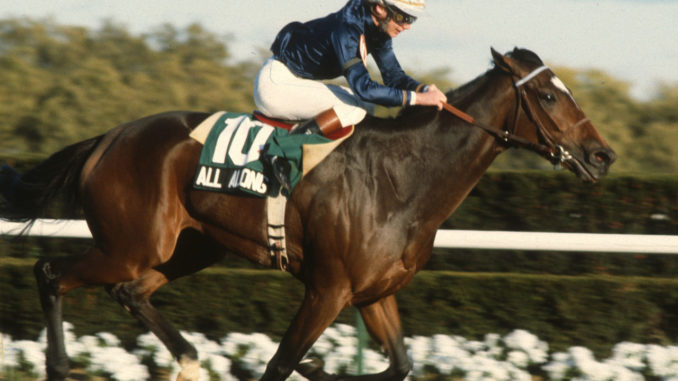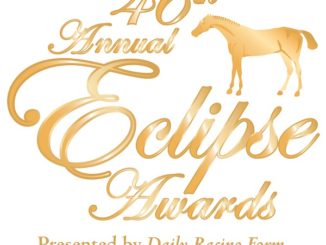
In celebration of the 50th year of the Eclipse Awards, Brisnet staff and contributors have delved into the history of the past five decades of champions and come up with individual thoughts on the best, and not so best, among most of the equine divisions since 1971. We highlighted the 3-year-old males on Dec. 28, 3-year-old fillies Dec. 29, and other divisions are on tap daily Dec. 30-31.
For the marquee divisions of champion 3-year-old male and champion older dirt male, we’ve ranked the campaigns 1 through 50. For five other select divisions, our experts highlight what they believe were the top 10 and bottom 10 campaigns.
- ALL ALONG (1983)
Imagine a newly crowned Prix de l’Arc de Triomphe (G1) winner jetting across the Atlantic to dominate not just one, or two, but three late-season Grade 1s, all over males. That’s what All Along accomplished in the span of six weeks in the fall of 1983, cutting out a swath of conquest never to be duplicated. The Rothmans (aka Canadian) International (G1), Turf Classic (G1), and now-defunct Washington D.C. International (G1) dangled a $1 million bonus to entice a sweep, which was enough to put her in the record book, and make her Horse of the Year. The fact that she began her winning skein in the Arc puts her campaign on top.
- MIESQUE (1987)
Although North American racing fans remember Miesque for her back-to-back Breeders’ Cup Mile (G1) victories, she had already compiled an historically significant resume in Europe. Only the second filly to turn the 1000 Guineas (G1)/Poule d’Essai des Pouliches (French 1000 Guineas) (G1) double, Miesque also distinguished herself by beating older males in both the Prix Jacques le Marois (G1) and Prix du Moulin (G1). She capped her stellar 1987 campaign with a course-record blitz in 1:32.80 in the Breeders’ Cup at Hollywood Park. Her 1988 performances were good enough to repeat as the Mile winner and divisional champion, but her sophomore season stands out.
- PEBBLES (1985)
The first female ever to win the Eclipse Stakes (G1), inaugurated in 1886 at Sandown, Pebbles was also much the best in the Champion S. (G1) at its ancient home of Newmarket. She completed a still-unique hat trick in the Breeders’ Cup Turf (G1), dashing up the Aqueduct rail in course-record time in her one and only try at 1 1/2 miles. Four-for-five racing exclusively versus males in 1985, Pebbles had quite a career trajectory considering she was the previous year’s 1000 Guineas winner. Indeed, she began her 4-year-old season by taking a Group 2 mile event at Sandown, so her distance range at this level was exceptional.
- GOLDIKOVA (2010)
Entering 2010 as a two-time Breeders’ Cup champion, Goldikova excelled herself as a 5-year-old. Her three-peat in the Mile enhanced her legendary status stateside, but her European season was arguably the finest of her career as well. Goldikova’s highlights included the Prix d’Ispahan (G1) in course-record time at Longchamp, the Queen Anne (G1) at Royal Ascot, and the Prix de la Foret (G1) that eluded her in other years.
- TEPIN (2016)
After her breakout campaign in 2015, culminating in the Breeders’ Cup Mile, Tepin raised her historical profile considerably in her follow-up act. She invaded Royal Ascot for the Queen Anne and became the first American, moreover the first non-European shipper, to win the mile feature. And she added another marquee score over males in the Woodbine Mile (G1), extending her winning streak to eight. Tepin might have been a tad unlucky not to repeat in the Breeders’ Cup, where she rallied out wide as Tourist got a dream ground-saving run in the race of his life.
- OUIJA BOARD (2004)
While a few others could reasonably appear more than once in the top 10, Ouija Board warrants a duplication most of all. Her two Eclipse-winning campaigns (2004 and 2006) exemplify different standards of excellence. Slight preference is given to her sophomore season, respecting the prestige due to a dual classic winner. After turning the Epsom/Irish Oaks (G1) double handily, she tried the Arc without the benefit of a prep, didn’t have the cleanest run, and still rallied for a terrific third. The Breeders’ Cup Filly & Mare Turf (G1) was a relative walk in the park at Lone Star.
- OUIJA BOARD (2006)
The British aristocrat expanded her portfolio as an older distaffer, and her 2006 season made her legacy as a globetrotter. Ouija Board lost more often, but deserves credit for her series of bold ventures, all in Group 1s. The sun never set on a campaign that stretched from Dubai and Hong Kong back to Europe, North America, and finally a swan song in Japan. Her three wins came at major festivals – the Prince of Wales’s (G1) at Royal Ascot, the Nassau (G1) at Glorious Goodwood, and another Breeders’ Cup title – and she came agonizingly close in the Irish Champion (G1).
- APRIL RUN (1982)
If her achievements have faded from racing’s collective memory, perhaps overshadowed by All Along’s spree just a year later, April Run’s run to the Eclipse still stands up to scrutiny. The only female to win the Turf Classic twice, she scored her repeat victory in 1982 by a resounding 6 1/2 lengths. April Run then crushed the Washington D.C. International by the same gaudy margin, so she won two major titles over males by a combined 13 lengths. Her campaign at home in France had not been as productive, but she edged males in the Prix Foy (G3), and for the second straight year, went down by just three-quarters of a length in the Arc (third in 1981 and fourth in 1982). April Run concluded her career with a near-miss third in the Japan Cup.
- ROYAL HEROINE (1984)
Not only did Royal Heroine star in the inaugural Breeders’ Cup Mile, in a new American record of 1:32.60, but she also left the next year’s Mile winner, Cozzene, back in third. Yet one of Royal Heroine’s rare losses that year has added to her legacy – her runner-up effort to the venerable John Henry in the 1984 Arlington Million (G1). Nursed along to try to last a 1 1/4-mile trip well outside her wheelhouse, Royal Heroine was easily clear of the rest. Her other notable performances that season include an Inglewood H. (G3) win over males and a victorious swan song in the Matriarch (G1).
- ESTRAPADE (1986)
Still the only female to win the Arlington Million, Estrapade slammed them by five lengths, and that gives her the nod for inclusion here. She earned another marquee title in the Oak Tree Invitational (G1), going wire-to-wire by daylight over Theatrical. Estrapade was also third in a vintage Breeders’ Cup Turf to Manila and Theatrical, finishing ahead of a subpar Dancing Brave. Her 1986 record versus fellow distaffers was less memorable, but Estrapade set a 1 1/4-mile course mark of 1:59 in Hollywood’s Beverly Hills H. (G2).
***
Now for the other end of the spectrum, the 10 Eclipse-winning campaigns that do not stand up as well from an historical perspective. Since the turf female division was spun off into a separate category in 1979, eight years after the Eclipse Awards began, the total number of champions is 42. Remember this is no knock on their quality as individuals – just an assessment of how their years compare to other champions in the division.
- TRILLION (1979)
To be fair, Trillion’s quartet of seconds in the Canadian International, Turf Classic, Oak Tree Invitational, and Washington D.C. International represents a high level of form. Twice she came close to that year’s champion turf male, Bowl Game, especially when just a neck back at Aqueduct. But from a philosophical standpoint, championships ought to involve winning, and Trillion endured 10 straight losses in her Eclipse campaign. Her prolonged skid tempers enthusiasm for her two Group 2 scores over males early in the year.
- FLAWLESSLY (1992)
Underscoring the point that these rankings are about individual years, and not overall merits, Flawlessly winds up here because her first Eclipse in 1992 is a little less noteworthy than her 1993 championship. She did not travel outside her Southern California base, did not venture outside female company, and lost two of three meetings to Super Staff. For a garden-variety turf distaffer, three Grade 1 wins would be a career year, but Flawlessly compiled an arguably better campaign in 1993.
- LADY ELI (2017)
If judged on sheer talent and character, Lady Eli would leapfrog well above this relatively low spot on the list. But her 2017 Eclipse honored a campaign that was better than the rest, not one of historic proportions. Her troika of the Gamely (G1), Diana (G1), and Ballston Spa (G2) was bookended by upset losses in both the Jenny Wiley (G1) and Breeders’ Cup Filly & Mare Turf, where she was wounded in early rough-housing that ended her hopes. That misfortune summed up the gnawing what-might-have-beens of a career, and life, nearly ended by laminitis in 2015. Lady Eli marked her greatness by returning to the top level afterward, but it cost her a lot of time in what should have been her prime. If not for the dread disease, chances are she would have earned an Eclipse sooner, with more prizes to her name.
- GOLDEN APPLES (2002)
Another Breeders’ Cup hard-luck story, Golden Apples was a troubled fourth in the 2002 Filly & Mare Turf, over a yielding Arlington course that didn’t suit her anyway. She also just missed in the Matriarch, but her scores in two divisional majors – the Beverly D. (G1) and Yellow Ribbon (G1) – were enough to take the Eclipse.
- LAHUDOOD (2007)
Capturing the Breeders’ Cup Filly & Mare Turf on top of the Flower Bowl (G1) makes for a logical Eclipse winner. But Lahudood flopped in the Beverly D. in her only other stakes appearance of 2007, which explains her 21-1 price in the Flower Bowl. She was also an 11-1 outsider in a soggy Breeders’ Cup at Monmouth.
- DAYATTHESPA (2014)
Opportunistic when parlaying a modest pace into a Filly & Mare Turf wire job at Santa Anita, Dayatthespa had a truncated four-race campaign. Her first stakes win of 2014 came over fellow New York-breds in the Yaddo, and her First Lady (G1) score set her up for the Breeders’ Cup.
- ZAGORA (2012)
Counterfactual time: if The Fugue isn’t throttled in traffic for most of the stretch of the 2012 Filly & Mare Turf, Zagora probably doesn’t win. You don’t have to agree with that interpretation to see Zagora’s campaign as more redolent of a divisional mainstay than a champion. To her credit, she won graded stakes from Tampa to Pimlico and Saratoga, where she set a course record in the Ballston Spa. Still, she was beaten in her three prior Grade 1 assignments of the season, including in the Diana by the brilliant Winter Memories who never raced again. Zagora was rightly rewarded for her high-class consistency, but the context can’t be ignored.
- WANDESTA (1996)
It’s tough to finish ahead of males in a graded stakes, only to lose to a fellow distaffer. Wandesta experienced that in 1996 – twice – at the hands of Windsharp. Denied by a neck in the San Luis Rey (G1) after playing second fiddle in the San Luis Obispo (G2), Wandesta finally exacted revenge on Windsharp in the Matriarch. That lone Grade 1 at season’s end netted her the championship, as Windsharp sustained a series of losses versus males in a more ambitious campaign.
- BROWN BESS (1989)
The pride of Northern California twice descended south to take marquee events, the Ramona and Yellow Ribbon, and placed third to males in the Golden Gate H. (G2). Yet a season spent mostly outside the major racing centers didn’t give Brown Bess the opportunity to boost her credentials.
- LAUGH AND BE MERRY (1990)
Laugh and Be Merry was admirably reliable, never missing the exacta in eight outings in 1990, but her Eclipse rests on her signature win in the Flower Bowl. Runner-up in a trio of Grade 2s, she signed off on a winning note in the Queen Charlotte H. (G3) at the Meadowlands.



